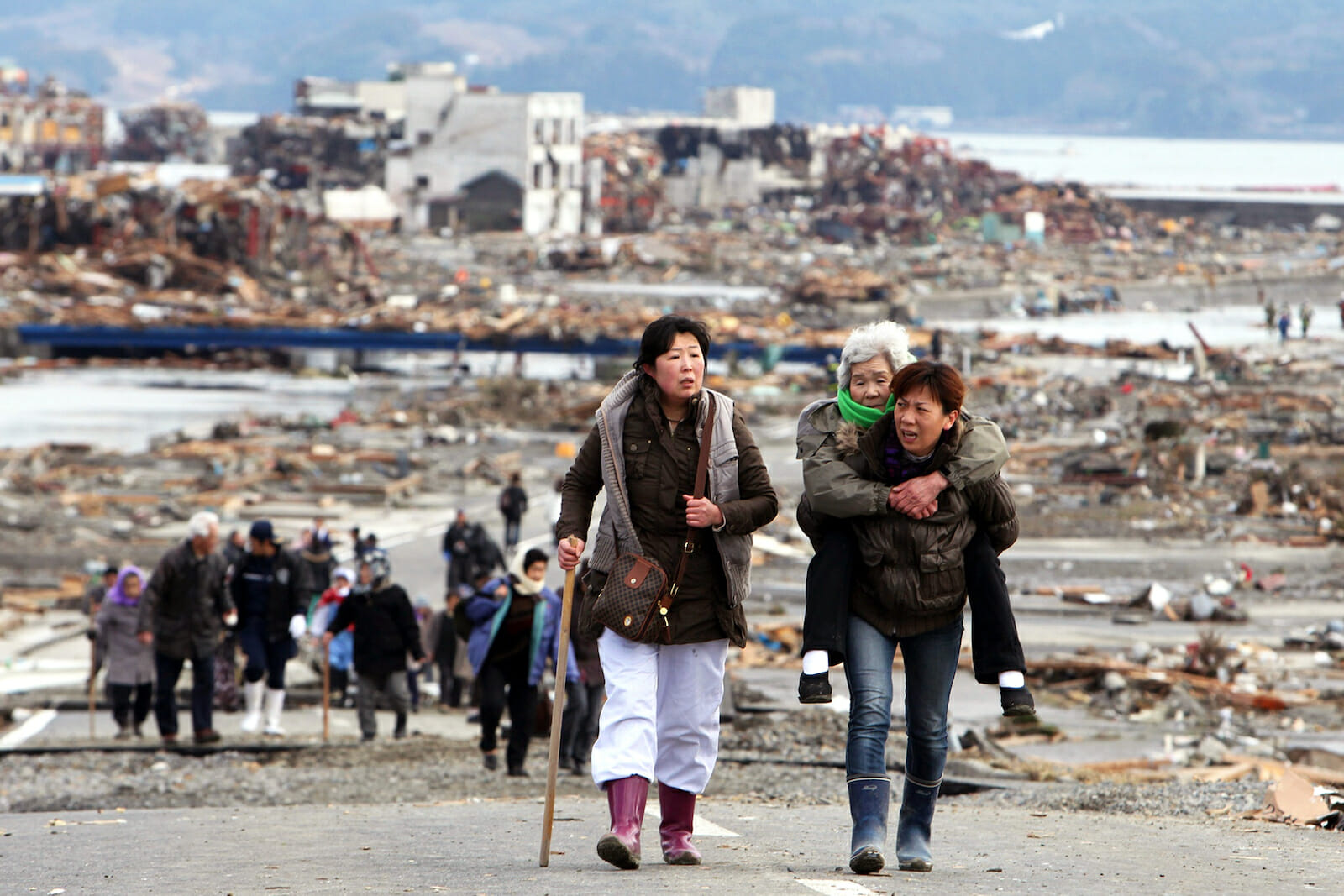
Japan’s 3/11: Dubious Progress at Rebuilding
The anniversary of Japan’s 3/11 is approaching. “3/11” is what the Japanese call the series of disasters which struck northern Japan in March of 2011; the earthquake, tsunami, and the Fukushima Daiichi nuclear power plant meltdown. It is time yet again to examine what happened, how it happened, what the prognosis is for the future. Japan is the only country in the world to have suffered two atomic attacks by a foreign power during World War II and a third, a homegrown nuclear disaster fomented by its own Nuclear Power Company, just two years ago.
I have spent most of the last year closely following Japan and the world’s response to that nation’s string of disasters. I spoke on Tuesday, Feb. 5, 2013, to the Rochester Institute of Technology (RIT) and addressed the country’s progress in dealing with the disasters and creating constructive change for the people of northern Japan. I was joined via telephone from Osaka, Japan by RIT alumnus Deven Neel. Neel’s speech, which I moderated, dealt with his experiences volunteering with the relief efforts in the region.
I opened with a brief review of the BBC’s “This World: Inside the Meltdown,” a documentary of the March 2011 meltdown of the Fukushima nuclear power plant. The documentary presents scenes of chaos at Fukushima at the nuclear power plant, and, in Tokyo at the halls of power, where governmental functionaries ran madly about like ants. And where ordinary men were the heroes, especially the volunteers over 50 “the Fukushima 50” who were not likely to have any more children and who therefore felt they could take the risk and enter the reactors.
The apparent exception to the governmental chaos was Prime Minister Kan, who decided to fly to Fukushima to find out what was going on and who took action, compelling the TEPCO plant manager to negotiate with TEPCO not to abandon the plant entirely but let the bulk of the workers go home. Leaving the “Fukushima 50” in place, a valiant skeleton crew.
One of the most striking images here —the government in Tokyo remained remote and un-responsive throughout this until a plume of radiation drifted across the sky towards Tokyo.
My review of the BBC film led into Neel’s speech on volunteers in Fukushima. As a backdrop to Neel’s comments, a silent homemade film on the tsunami in northern Japan was shown. Because the movie was a mix of handheld camera, cell phone, and movie camera footage taken by the inhabitants as they stood on roofs to escape the water—it was jerky, erratic, very immediate and effective. The huge walls of tsunami water smashing the levees, picking up entire towns and floating them down the river had a powerful effect on the audience—many of whom said they had never seen this footage before.
As the giant walls of water smashed down on his town in the film, Neel told the audience what it was like to experience an earthquake, tsunami and a nuclear meltdown in your back yard:
Everywhere, there was fear…the overwhelming fear of radiation in the air and water and in products for consumption. The discovery of radiation in mother’s milk was a spur to genuine outrage and is one of the flashpoint issues that got Japanese women to join mass protests against nuclear power.
Addressing the post-nuclear disaster, I asked Neel who in his opinion had been the most active in helping people deal with the disasters? Neel said that in his opinion private and individual efforts and those of local government and “community leaders” had been the most effective and notable. He added that local government, the Self Defense Forces and an unofficial group of construction companies and public employees had been invaluable in helping to clear debris and organize refugee shelters.
I asked Neel about the impact of the disasters on local people and industries, and the work of the volunteers:
While industries in Fukushima have had a very hard time, other areas of Tohoku are starting to see the rebirth of their agricultural and fishing industries. New brands have been created to better market their products, and I have even heard of tomatoes being intentionally grown in salt-contaminated soil to create a new, saltier tasting tomato.
However…the farmers and fishermen of Tohoku were hit hard. The tsunami left rice fields and farmland in ruins. The high salt content deposited in the soil made it generally unusable. The disasters also depleted the fish and the shellfish populations, formerly a booming local product. Consequently, many volunteers from Minamisanriku turned to help struggling local industries. They worked to create new fields and greenhouses a little further from shore, to prepare oyster farms and collect and prepare local seaweed for the market.
I asked Neel about the housing situation and about mental health, specifically about depression:
At the start, there were few complaints. Even small living quarters provided better shelter than the cardboard boxes and plastic and plywood structures, one per family, used as refugee shelters in the gyms and schools. But problems arose. Most of the temporary housing were small units, quickly built, side by side, in row after row, in former parking lots, or on empty lots of land. They were not especially comfortable and certainly not roomy.
Many people moved out at the first chance– to move in with relatives, into a new house, or out of Tohoku altogether. Many housing areas were populated by a group of people from different areas, different towns. As a result, people in temporary housing did not always have a sense of “community.” Those who have remained have experienced a sense of isolation and having been “left behind.”
Neel then discussed the mental health needs in the region:
In my opinion, the most painful issue for survivors is depression. Depression is the biggest problem among the survivors, particularly among the elderly. With no work, no family, and without their community surrounding them, many were overwhelmed by a sense of depression which set in hard. They needed human contact; a more personal touch.
After Neel had left the call, I addressed the audience. I noted that it might seem that we had nothing but grim, dreadful news to report about the triple disasters. But in fact, there are at least two areas that give some reason for hope: The heroic work done not only by volunteers but by Japan’s top architects, who have been working tirelessly to plan for the reconstruction of entire communities and the great work done by Japan’s women, who are leaving their houses in droves for the first time certainly since the 60’s to take part in gatherings protesting the return to a nuclear Japan. This is truly a revolution. And it gives us hope for the future.
The journalism students asked me repeatedly about why I felt the changes in the role of Japanese women were so remarkable. I first gave them a mildly comical account of what it was like to be a foreign woman in Japan thirty years ago – a woman who was expected to learn how to do all the things good Japanese rural housewives could do. Towards the end of the presentation I wanted to celebrate the work of women in Japan.
Japanese women, particularly, the women of Fukushima – those most directly affected by the fumes of radiation – have left their laborious endless housekeeping to become powerful public advocates. They are expressing their outrage against the overwhelming and terrible damage done to Japan’s air, water and earth by the meltdown of the Daiichi Power Plant. These Fukushima women are protesting against the actions – or failures to act – of the Japanese government and of the nuclear power company TEPCO.
Japan’s triple disasters have caused another earthquake for the role of Japanese women in society. David H. Slater of Japan’s Sophia University has remarked that this is the largest and most effective set of demonstrations in Japan since the U.S.-Japan treaty protests of the 1960s and 1970s. It has brought together a disparate group of activists, young families, women, office workers, and union protestors. He notes that for the first time, women have consistently been at the forefront of protest.
Slater astutely remarks that the group, “Woman of Fukushima Against Nukes,” has skillfully exploited the privileged position of women. As child bearers and nurturers, women are at the core of Japanese society, thus, despite the proverb quoted in the title, their influence is far stronger than one might expect.
Several scholars of modern Japan have remarked that this nuclear crisis has fomented radical change that may happen and was previously unthinkable in Japan. A population typically referred to as passive, docile, and obedient when infused with the powerful energy of anger and outrage, can push through crucial changes in a world almost literally glowing in the dark.

